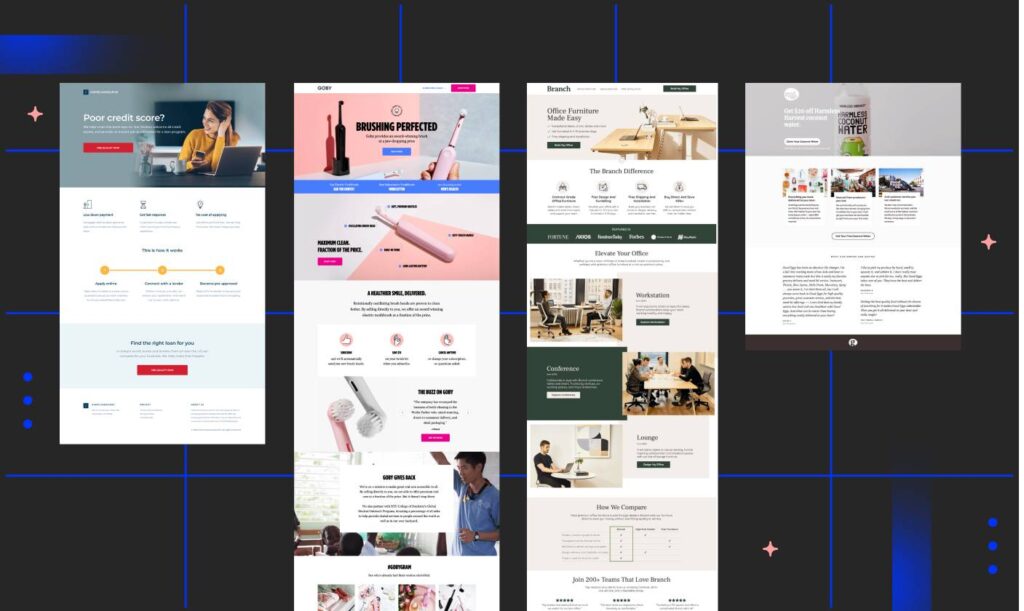When it comes to creating a brand identity, your logo is a crucial element. It’s the visual representation of your company and plays a significant role in how your audience perceives your brand. There are several types of logos, each with its unique characteristics and uses. In this blog, we’ll explore nine popular types of logos and provide tips on how to use them effectively.
Introduction to Logo Types
Before diving into the different types of logos, it’s essential to understand that your logo should align with your brand’s identity and values. The right logo can enhance brand recognition, convey your message clearly, and make a lasting impression.
1. Wordmarks (Logotypes)
What Are Wordmarks?
Wordmarks are logos that consist of the company’s name in a unique, stylized font. They are purely text-based and focus on typography to create a memorable brand image.
Examples of Wordmarks
- Coca-Cola
- Visa
How to Use Wordmarks Effectively
- Choose a Distinctive Font: Your font should be unique and reflective of your brand personality.
- Keep It Simple: A clean design helps in making the name easily readable and memorable.
- Consider Custom Typography: Custom fonts can make your wordmark stand out from the competition.
2. Lettermarks (Monograms)
What Are Lettermarks?
Lettermarks, or monograms, use the initials of a company’s name to create a simple yet effective logo. This type of logo is ideal for businesses with long or complex names.
Examples of Lettermarks
- IBM
- H&M
- HP
How to Use Lettermarks Effectively
- Focus on Legibility: Ensure that the initials are clear and easily recognizable.
- Use Bold Design Elements: Incorporate bold lines or unique shapes to make the monogram stand out.
- Keep It Versatile: Your lettermark should look good in various sizes and applications.
3. Pictorial Marks (Iconic Logos)
What Are Pictorial Marks?
Pictorial marks use symbols or icons to represent the brand. These logos are visually descriptive and convey a clear message through imagery.
Examples of Pictorial Marks
- Apple
- Target
How to Use Pictorial Marks Effectively
- Select a Relevant Icon: Choose a symbol that represents your brand’s values or products.
- Ensure Scalability: The icon should be recognizable and clear in both small and large sizes.
- Balance Simplicity and Detail: Aim for a design that’s simple enough to be memorable but detailed enough to be distinctive.
4. Abstract Logos
What Are Abstract Logos?
Abstract logos use geometric shapes and forms to create a unique symbol that represents the brand. These logos are less literal and focus on creating a visual impact.
Examples of Abstract Logos
- Nike
- Pepsi
- Adidas
How to Use Abstract Logos Effectively
- Create a Strong Visual Impact: The abstract design should be bold and engaging.
- Ensure Brand Alignment: The abstract form should resonate with your brand’s message or ethos.
- Consider Color Psychology: Use colors that align with your brand’s emotions and values.
5. Emblem Logos
What Are Emblem Logos?
Emblem logos combine text and imagery within a single frame or shape. They often have a classic and traditional look and are commonly used by organizations, schools, and government agencies.
Examples of Emblem Logos
- Harvard University
- Starbucks
- NFL
How to Use Emblem Logos Effectively
- Choose a Strong Shape: The shape or frame should enhance the design and make it cohesive.
- Balance Text and Imagery: Ensure that the text is legible and integrates well with the imagery.
- Use Traditional Fonts: Classic fonts can enhance the emblem’s traditional appeal.
6. Combination Marks
What Are Combination Marks?
Combination marks integrate both text and symbols into a single logo. This type of logo combines the strengths of wordmarks and pictorial marks, providing flexibility in branding.
Examples of Combination Marks
- Burger King
- Doritos
- Puma
How to Use Combination Marks Effectively
- Ensure Cohesion: The text and symbol should work together harmoniously.
- Maintain Flexibility: The logo should be versatile enough to be used in various contexts.
- Use Clear Branding: Both elements should contribute to a clear and consistent brand message.
7. Mascot Logos
What Are Mascot Logos?
Examples of Mascot Logos
- KFC (Colonel Sanders)
- Pringles (Mr. Pringle)
- Geico (Gecko)
How to Use Mascot Logos Effectively
- Choose a Relatable Character: The mascot should embody your brand’s personality and values.
- Ensure Versatility: The mascot should be adaptable for various uses, from packaging to advertising.
- Maintain Consistent Style: Keep the mascot’s style consistent across all branding materials.
8. Dynamic Logos
What Are Dynamic Logos?
Dynamic logos are adaptable and change based on context or application. They offer flexibility and can evolve over time, making them suitable for modern brands.
Examples of Dynamic Logos
- Google (changing Doodles)
- MTV
- BBC
How to Use Dynamic Logos Effectively
- Ensure Brand Consistency: Even though the logo changes, it should still be recognizable as part of your brand.
- Adapt to Context: Use variations of the logo that fit different contexts or campaigns.
- Maintain Design Principles: Keep core elements consistent to ensure the logo remains cohesive.
9. Minimalist Logos
What Are Minimalist Logos?
Minimalist logos focus on simplicity and clean design, using minimal elements to create a powerful impact. These logos are often sleek and modern, emphasizing functionality over ornamentation.
Examples of Minimalist Logos
- Apple
- Nike
- FedEx
How to Use Minimalist Logos Effectively
- Emphasize Simplicity: Use clean lines and avoid unnecessary details.
- Focus on Core Elements: Ensure that essential elements of your brand are highlighted.
- Use Negative Space: Leverage negative space to create a memorable and effective design.
Frequently Asked Questions (FAQs)
Q1: How do I choose the right type of logo for my business?
A1: Consider your brand’s personality, target audience, and industry. Different types of logos serve different purposes, so choose one that aligns with your brand’s identity and goals. For example, a tech startup might opt for an abstract logo, while a restaurant might choose a combination mark.
Q2: Can I change my logo type after I’ve established my brand?
A2: Yes, you can update or change your logo type as your brand evolves. However, it’s important to ensure that any changes maintain brand recognition and consistency. Rebranding should be done thoughtfully to avoid confusing your audience.
Q3: What are the benefits of using a combination mark?
A3: Combination marks offer the flexibility of both text and imagery, making them versatile for various applications. They can enhance brand recognition and provide more context about your business, which is useful for new brands.
Q4: How can I make sure my logo is effective across different platforms?
A4: Ensure that your logo is versatile and scalable. It should look good in various sizes and formats, from social media profiles to large banners. Testing your logo in different applications can help ensure its effectiveness.
Q5: Are there any common mistakes to avoid when designing a logo?
A5: Common mistakes include using overly complex designs, choosing fonts that are hard to read, and failing to ensure scalability. It’s also important to avoid trends that might quickly become outdated. Focus on creating a timeless design that reflects your brand’s identity.
Conclusion
Choosing the right type of logo is crucial for establishing a strong brand identity and making a lasting impression on your audience. By understanding the nine types of logos and how to use them effectively, you can create a logo that aligns with your brand’s values and resonates with your target audience. Whether you opt for a wordmark, pictorial mark, or any other type, ensure that your logo is memorable, versatile, and representative of your brand’s essence.
If you need further assistance or inspiration for your logo design, feel free to reach out or explore more resources on logo creation. Happy designing!







